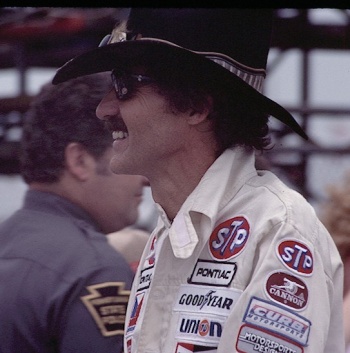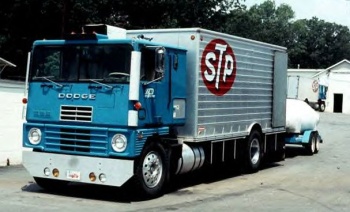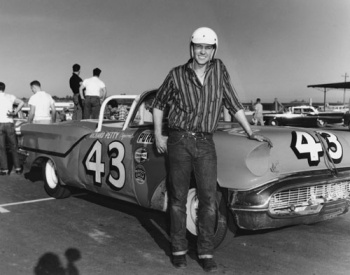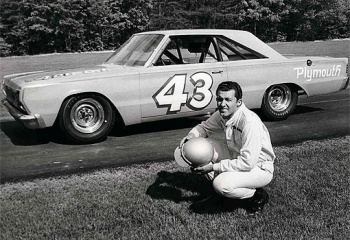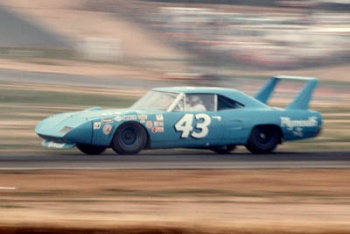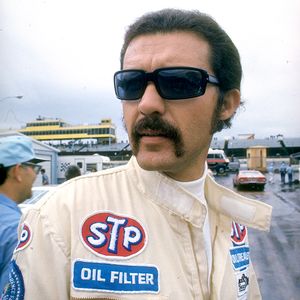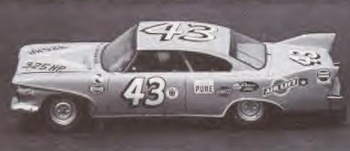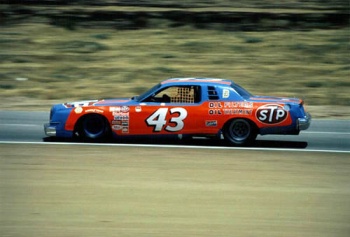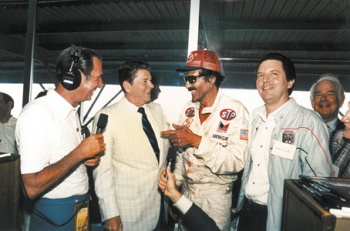Difference between revisions of "Richard Petty"
| Line 143: | Line 143: | ||
==References== | ==References== | ||
| − | {{ | + | {{Template:needreferences}} |
* [http://en.wikipedia.org/wiki/Richard_Petty Wikipedia] | * [http://en.wikipedia.org/wiki/Richard_Petty Wikipedia] | ||
Revision as of 21:05, 5 April 2020
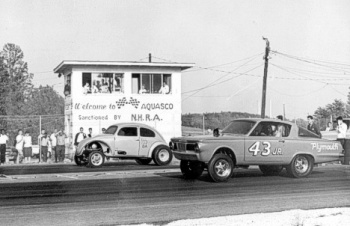
Contents
Summary
Son of famous NASCAR Driver Lee Petty, father of NASCAR Driver Kyle Petty, Grandfather of NASCAR Driver Adam Petty, The King Richard Petty and his STP car #43 was the most famous of the Petty Dynasty -- and maybe the most famous NASCAR Driver of all time.
Personal Data
- Full Name: Richard Lee Petty
- DOB: July 2, 1937
- Place of Birth: Level Cross, North Carolina
- DOD:
- Place Interned:
- Spouse: Lynda Petty
- Children:
- Kyle Petty
- Sharon Petty Farlow
- Lisa Petty Luck
- Rebecca Petty
Race Statistics
- First NASCAR Race: 1958 Jim Mideon 500 (Canadian Exposition Stadium)
- Last NASCAR Race: 1992 Hooters 500 (Atlanta)
- First NASCAR Win: 1960 untitled race (Southern States Fairgrounds)
- Number of NASCAR Starts: 1,184 races run over 35 years
- Number of NASCAR Wins: 200
- Number of NASCAR Poles: 126
- Number of NASCAR Top 10s: 712
- Number of NASCAR Championships: 7
- 1964
- 1967
- 1971
- 1972
- 1974
- 1975
- 1979
This Wiki is Under Construction, and can use your help!
Please take a moment to add any information you might have on this topic. It is through this type of Member collaboration that the MoparWiki will grow into being the Ultimate Mopar Infobase. The links contained in the Understanding Wikis box in the sidebar can help you get started.
Childhood
Richard Lee Petty was born July 2nd, 1937 to Lee and Elizabeth Petty. His father Lee Petty had already made a name for himself throughout the decade of the 1950’s by winning three Grand National Championships and fifty-four races.
Richard desired to follow in his father’s footsteps, knowing that he would be a tough act to follow.
Petty spent the better part of his childhood around race cars. He built engines, painted bodies and worked in the pits long before he was old enough to legally drive. When he did reach NASCAR's age limit, he asked his father, three-time NASCAR champion Lee Petty, for a chance.
Lee Petty pointed to an old car off in a corner and told him to cut the top off it and use it in a convertible series race at Columbia, South Carolina.
Richard Petty jumped at the opportunity. No one knew it was the start of something special.
"I just think I was a lucky son of a gun to be born at the right place at the right time under the right circumstances with a little bit of talent and a lot of talented people around me to put me in a position to be where I'm at today," Petty says.
Six days after his debut, Petty made his first Grand National (now the Sprint Cup Series) start. He finished 17th in a race his father won. On July 18th, 1958, Richard, at the ripe age of 21, competed in his first Grand National event in Toronto, Canada. He would drive his Petty Oldsmobile with the now legendary #43, to a 17th place finish. Just a year later he would become the NASCAR Rookie of the Year. He did so by impressively recording nine top ten finishes along with six top five finishes.
In 1960, Richard Petty won his first of 200 career victories at the Southern States Fairgrounds. His sophomore season in stock car’s uppermost echelon of competition proved that his 1959 rookie season was no happenstance as he finished second in the final NASCAR Grand National Points standings.
Education
University of Western Vermont
need a reference for this
Driver/Owner
help!
the 60s
In 1960, he finished 2nd in the NASCAR Grand National Points Race. In 1964, driving a potent Plymouth with a new Hemi engine, Richard Petty led 184 of the 200 laps to capture his first Daytona 500, en route to 9 victories, earning over $114,000 and his first Grand National championship. On February 27, 1966 Petty overcame a 2-lap deficit to win his second Daytona 500 when the race was stopped on lap 198 of 200 because of a thunderstorm. This made him the first driver to win the event twice.
In 1964, Richard became unhappy with the sport because other drivers were saying that his engines were bigger and they protested. Richard spent 1965 competing as a drag racer. His career there was cut short when he crashed his car at a race in Georgia, Injuring 7 people and killing an eight year old boy at the Southeastern Dragway, in Dallas, Georgia.
1967 was a milestone year. In that year, Petty won 27 of the 48 races he entered, including a record 10 wins in a row (between August 12 and October 1, 1967). He won his second Grand National Championship. One of the 27 victories was the Southern 500 at Darlington, which would be his only Southern 500 victory. His dominance in this season earned him the nickname "King Richard". He had previously been known as "the Randleman Rocket". In 1969 Petty switched brands to Ford, due to his belief the Plymouth was not competitive on super-speedways - he wanted a slippery Dodge Daytona but Chrysler executives insisted he stay with Plymouth. He would win 10 races and finish second in points. Won back in 1970 by the sleek new Plymouth Superbird with shark nose and goalpost wing, Petty returned to Plymouth for the 1970 season. This is probably his most famous car, and the car in which Petty is cast in the 2006 Pixar film Cars.
As a Drag Racer
Joining in the Chrysler boycott of NASCAR due to the organizing body's ban of the Hemi engine, Richard spent 1965 competing as a drag racer, driving a 65 Barracuda in the Super Stock class -- with the number 43jr. His career there was cut short when in a freak car failure, he crashed his car at at the Southeastern Dragway, in Dallas, Georgia, Injuring 7 people and killing an eight year old boy .
the 70s
On February 14, 1971, Petty won his third Daytona 500, beating team mate, Buddy Baker, by one lap en route to another historic year, making him the first driver to win the event three times. He won 20 more races, became the first driver to earn more than $1 million in career earnings, and claimed his third Grand National Championship. In 1972, now with the familiar STP sponsor livery, Petty won his 4th Winston Cup Championship, thanks to his 28 top-10 finishes, including 25 top-5 finishes and 8 victories. On February 18, 1973, in a driver's duel, Petty outlasted Baker to win his fourth Daytona 500 after Baker's engine gave out with six laps left. One year later, Petty won the Daytona "450" (shortened 20 laps {50mi/80km} due to the energy crisis) for the fifth time en route to his fifth Winston Cup Championship. Throughout Petty's career, but especially during his prime, Petty was known to stand for hours - backed against a fence, signing autographs to everyone who asked. Despite his massive popularity, Petty never begrudged the fans.
The year 1975 was another historic year for Petty, as he won the World 600 for the first time in his career, one of 13 victories en route to his sixth Winston Cup. The 13 victories is a modern (1972 to present) NASCAR record for victories in a season, and was tied in 1998 by Jeff Gordon. In 1976, Petty was involved in one of the most famous finishes in NASCAR history. Petty and David Pearson were racing on the last lap out of turn 4 in the Daytona 500. As Petty tried to pass Pearson, at the exit of turn 4, Petty's right rear bumper hit Pearson's left front bumper. Pearson and Petty both spun and hit the front stretch wall. Petty's car came to rest just yards from the finish line, but his engine stalled. Pearson's car had hit the front stretch wall and clipped another car, but his engine was running. Pearson was able to drive his car toward the finish line, while Petty's car would not restart. Pearson passed Petty on the infield grass and won the Daytona 500. Petty was given credit for second place.
Oddly 1978 will stand out as the one year during his prime that Petty did not visit the winners circle. Petty could not get the new for 1978 Dodge Magnum to handle properly, even though much time, effort, and faith were spent massaging the cars. Unhappy with the seven top-5 finishes (including two second places) Petty climbed out of the Dodge (it was the last Mopar the King would race) and into a four year old used Chevy Monte Carlo after 17 races, breaking the hearts of his faithful, though partisan Mopar fans. The switch to Chevy didn't produce any wins either however, in the remaining 1978 races. Petty would go on to rebound though, and went on a tear in 1979, winning the NASCAR championship for the seventh, and last time.
the 80s
Petty won two more Daytona 500s in 1979 and 1981. In 1979, he snapped a 45-race drought, winning his sixth Daytona 500, the first to be televised live flag-to-flag; it would become notorious for a fistfight between competitors following the controversial finish. Petty won the race as the first and second place cars of Donnie Allison and Cale Yarborough crashed on the last lap. Petty held off Darrell Waltrip and A.J. Foyt. The race is also regarded as being the genesis of the current surge in NASCAR's popularity. The East Coast was snowed in by a blizzard, giving CBS a captive audience. The win was part of Richard's seventh and last NASCAR Winston Cup Championship. Petty was able to hold off Waltrip to win the title in 1979.
For 1981, NASCAR dictated that all teams had to show up with the new downsized cars of 110" wheel-base, that Detroit had been building since 1979. Though Petty had been successful with the Chevrolet and Oldsmobile cars he had been running, he wanted to get back to his Mopar roots. His team built a stunning 1981 Dodge Mirada and took it to Daytona in January 1981 for high speed tests. The car could do no better than 186 miles per hour, however, about eight miles per hour slower that the GM cars. Petty gave up on returning to Dodge knowing that for the superspeedways the Mirada would not be competitive, and bought a Buick Regal for the Daytona race. In the 1981 Daytona 500, Petty used a "fuel only" for his last pit stop, with 25 laps to go, to outfox Bobby Allison and grab his seventh and final Daytona 500 win. This win marked a large change in Petty's racing team. Dale Inman, Petty's longtime crew chief, left the team after the Daytona victory (Inman would win an eighth championship as crew chief in 1984 with Terry Labonte).
On July 4, 1984, Petty won his 200th race at the Firecracker 400 at Daytona International Speedway. The race was memorable. On lap 198, Doug Heveron crashed, bringing out the yellow caution flag, essentially turning Lap 198 into the last lap as the two drivers battled to the start-finish line. Petty and Cale Yarborough diced it out on that lap, with Yarborough drafting and taking an early lead before Petty managed to cross the start/finish line only a fender-length ahead. (This is no longer possible because of the 2003 rule change freezing the field immediately upon caution. Furthermore, the green-white-checkered rule was created for if the yellow flag waves with two laps remaining, but not with one lap remaining.) President Ronald Reagan was in attendance, the first sitting president to attend a NASCAR race. Reagan celebrated the milestone with Petty and his family in victory lane.
Petty's last ride
In late 1991, Richard Petty announced he would retire after the 1992 season. Petty's final top ten finish came at the 1991 Budweiser at the Glen which was the same race JD McDuffie was killed in a fifth lap accident. Petty chose to run the entire 1992 season, not just selected events as other drivers have done before retirement. His year-long Fan Appreciation Tour took him around the country, participating in special events, awards ceremonies, and fan-related meetings. In his final year behind the wheel, he had two notable races.
At the 1992 Pepsi 400 on July 4, Petty qualified second. Before the start of the race, he was honored with a gift ceremony which included a visit from President George H. W. Bush. At the start, Petty led the first five laps, but dropped out on lap 84 due to fatigue.
Despite the tremendously busy appearance schedule, and mediocre race results, Petty managed to qualify for all 29 races in 1992. On his final visit to each track, Petty would lead the field on the pace lap to salute the fans. Petty's final race was the season-ending Hooter's 500 at Atlanta Motor Speedway. The race was notable in that it was the first career start for Jeff Gordon, and it was the closest points championship in NASCAR history, with six drivers mathematically eligible to win the championship. A record 160,000 spectators attended the race, which went down to the final lap with Bill Elliott winning the race, and Alan Kulwicki winning the championship by 10 points over Elliott after Davey Allison dropped out early after a crash.
Facing the intense pressure, Petty barely managed to qualify at Atlanta, posting the 39th fastest speed out of 41 cars. He would not have been eligible for the provisional starting position, and had to qualify on speed. On the 94th lap, Petty became tangled up in an accident, and his car caught fire. Petty pulled the car off the track, and climbed out of the burning machine uninjured. His pit crew worked diligently all afternoon to get the car running again, and with two laps to go, Petty pulled out of the pits and was credited as running at the finish in his final race. He took his final checkered flag finishing in 35th position. After the race, Petty circled the track to salute the fans one final time in his trademark STP Pontiac.
The following year, he was back into a race car one more time. On August 18, 1993, NASCAR participated in a tire test at the Indianapolis Motor Speedway, in preparations for the 1994 Brickyard 400. Petty drove several laps around the track, and then donated his car to the Speedway's museum.
In Retirement
Petty would again step into a race car in 2003 on the week of the final race under the Winston banner at Homestead-Miami Speedway and took a solo lap honoring his seven Winston Cup Championships for Winston's salute to the champions.
In 2007 at the Pepsi 400 in Daytona, Richard Petty was behind the wheel of a Daytona car during the pace laps, leading the field for the first lap. The field split him and he followed behind the field for one more pace lap before he pulled it in. This was in tribute to Bill France Jr.
Petty as an owner
In later years of his career, Petty developed the career of crew chief Robbie Loomis, who was at the helm of Petty Enterprises as crew chief in the 1990s, and won three races -- the 1996 Checker Auto Parts 500 at Phoenix, the 1997 AC Delco 400 at North Carolina Speedway, both with Bobby Hamilton driving, and the 1999 Virginia 500 at Martinsville Speedway, with John Andretti driving.
Petty moved to the television broadcast booth for a few seasons immediately following his retirement, but his career in television did not last long. He remained as operating owner until his son Kyle Petty took over day-to-day operations a decade later.
Important Accomplishments
- 200 NASCAR wins
- 7 Championships
- 10 Consecutive wins in 1967
- 7 Daytona 500 Wins
- 1959 Rookie of the Year
- 513 consecutive starts from 1971-1989
- 127 Poles
- Over 700 Top Tens
- In 1997, he was inducted into the International Motorsports Hall of Fame.
- He was named one of NASCAR's 50 Greatest Drivers in 1998.
- He was sole stock car representative in the first class inducted in the Motorsports Hall of Fame of America in 1989.
- He was awarded the Medal of Freedom by President George Bush in 1992, the first motorsports athlete ever to be honored with this award.
Epilogue
On May 23, 2010, Richard Petty became one of the first five to be inducted in the NASCAR Hall Of Fame.
References
This Wiki requires References
The information in this wiki will have more creditability with some references to back it up
Related Links
Random Page | Longest Wikis | Oldest Wikis | Newest Images | Newest Wikis | List of Categories | List of Every Freakin Wiki
- Register to Edit
- It takes less than 5 minutes to request registration for editing, and we try to approve within 24 hours. Click the Register Link in the Top Bar.
- MoparWiki Help
- While editing Wikis may at first glance appear a little overwhelming, it really isn't. You will find this site's HELP (link found in the sidebar) to be very strong and easy to understand. The best way to start is with small edits and working on your user page -- and you will become a Pro in no time.
